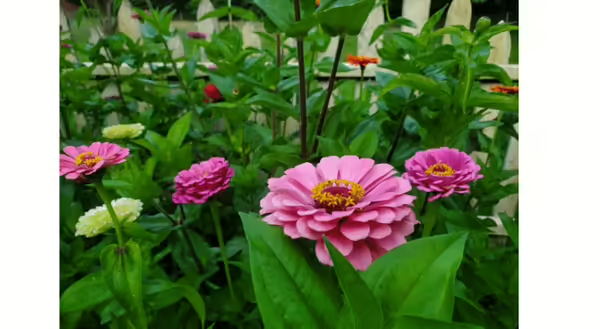
Landscaping is typically designed to provide functional beauty to our yards and community spaces by brightening up the build environment with plant life. While beauty can lie in the form of interesting foliage, brilliant fall color, or unique growth habit, flowers are always the showstoppers of the growing season. In fact, many gardeners plan their entire landscape based on flowering displays.
With all the recent attention on pollinators, flowering plants have become even more important as we all look for ways to better support their declining populations. As I have looked for more options to produce more floral resources in my own landscape, I’ve started to seek out those plants that have a reliable flower display, produce abundant blooms with little maintenance and draw in the pollinators. While that criteria may define the proverbial “perfect” garden plant, its not an easy set of attributes to align and I find that many plants fall short in one way or another.
Zinnias (Zinnia spp.) are perhaps one of the plants that fit bill with respect to their bloom time and duration. As a gardener, I typically focus more on perennials, and especially native perennials, but these non-native annuals really have a lot to offer for both humans and animals.
The genus Zinnia is comprised of 17 species worldwide and its members vary from short-statured plants only inches tall to upright, woody specimens. The native range of these plants extends from the US Southwest all the way to South America, spanning a considerable array of habitat and climate. This diversity has lent well to breeding efforts and today there are almost uncountable varieties and hybrids offering a very wide selection of flower colors and shapes.
Zinnias are easily grown in any location with ample sun and good soil drainage, making them a tried-and-true plant choice for novice to advanced gardeners. They readily grow from direct seeding and can also be purchased as seedlings, with a wide variety typically available in garden centers each spring and summer. I’ve had excellent luck with direct seeding into my garden early in the growing season, but for a head start, seeds can also be started indoors several weeks before the last frost.
Throughout the summer, deadheading will help ensure a season of blooms, but zinnias are relatively maintenance free and extremely drought tolerant. The biggest issue I’ve had with these plants is powdery mildew, but new varieties have excellent resistance and most full sun locations keep foliage dry enough to limit infection.
Most varieties make excellent cut flowers, lasting about a week in a vase, sometimes up to 2 weeks. Their sturdy, stout stems work well in floral arrangements, especially taller varieties.
Pollinators, especially butterflies, find zinnias attractive and make use of their floral resources throughout the months of blooms. Although not all zinnias are the best pollinator food sources since many varieties produce double flowers, which have little or no pollinator value.
Double flowering is a naturally occurring mutation that breeders have captured to produce more attractive flowers. This mutation is not limited to zinnias, occurring across a wide range of other species. It has been used extensively by plant breeders to create flowers with more abundant petals to add either more color or larger bloom sizes. However, this mutation precludes the development of reproductive flower parts to produce dense flowers, jam-packed with colorful petals.
So, double flower structures don’t offer the pollen and nectar that single flowers produce, although they do produce incredibly beautiful blooms that tend to remain open longer since less energy and growth is focus on seed production.
Gardeners interested in supporting pollinators should seek out single flower varieties. Most common zinnia varieties come from either Z. angustifolia or Z. elegans. In general, Z. angustifolia varieties are single flower, whereas Z. elegans are typically double flower plants.
With their long-lasting flowering display, zinnias work in huge variety of garden settings. In recent years, my wife has started seedlings that we use to fill in blank spots in our landscaping beds. They work great as a quick fill in if something doesn’t come up from last year or are an excellent space holder in newer beds that are still awaiting the perfect perennial.
We’ve used them as part our vegetable garden rotation to attract pollinators that control pests on veggies. We typically direct seed them over an entire bed that was in vegetable production last year. However, I have seen really great use of zinnias intermixed into the vegetable garden to provide a beautiful splash of color while producing abundant cut flowers throughout the season.